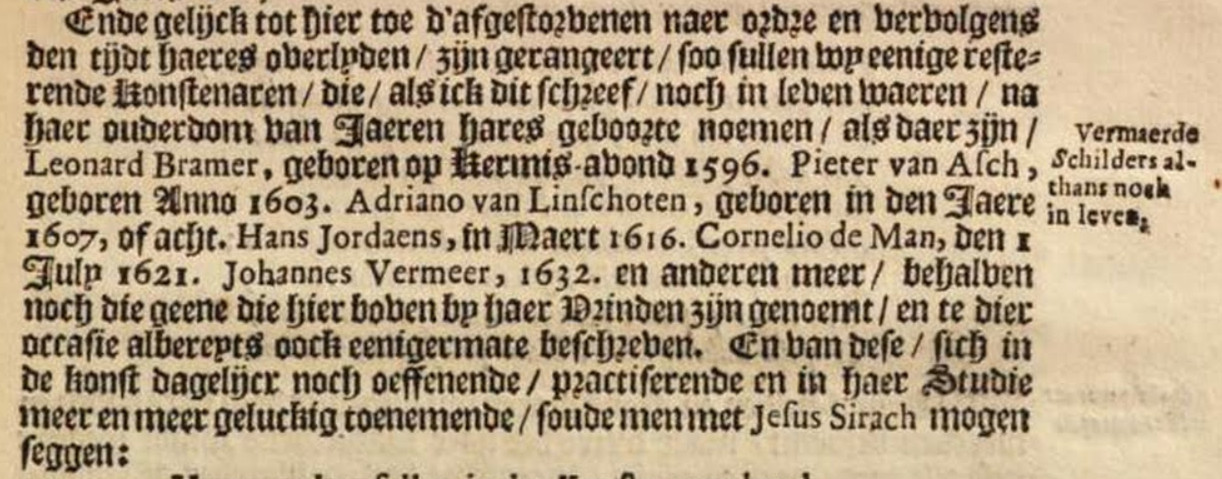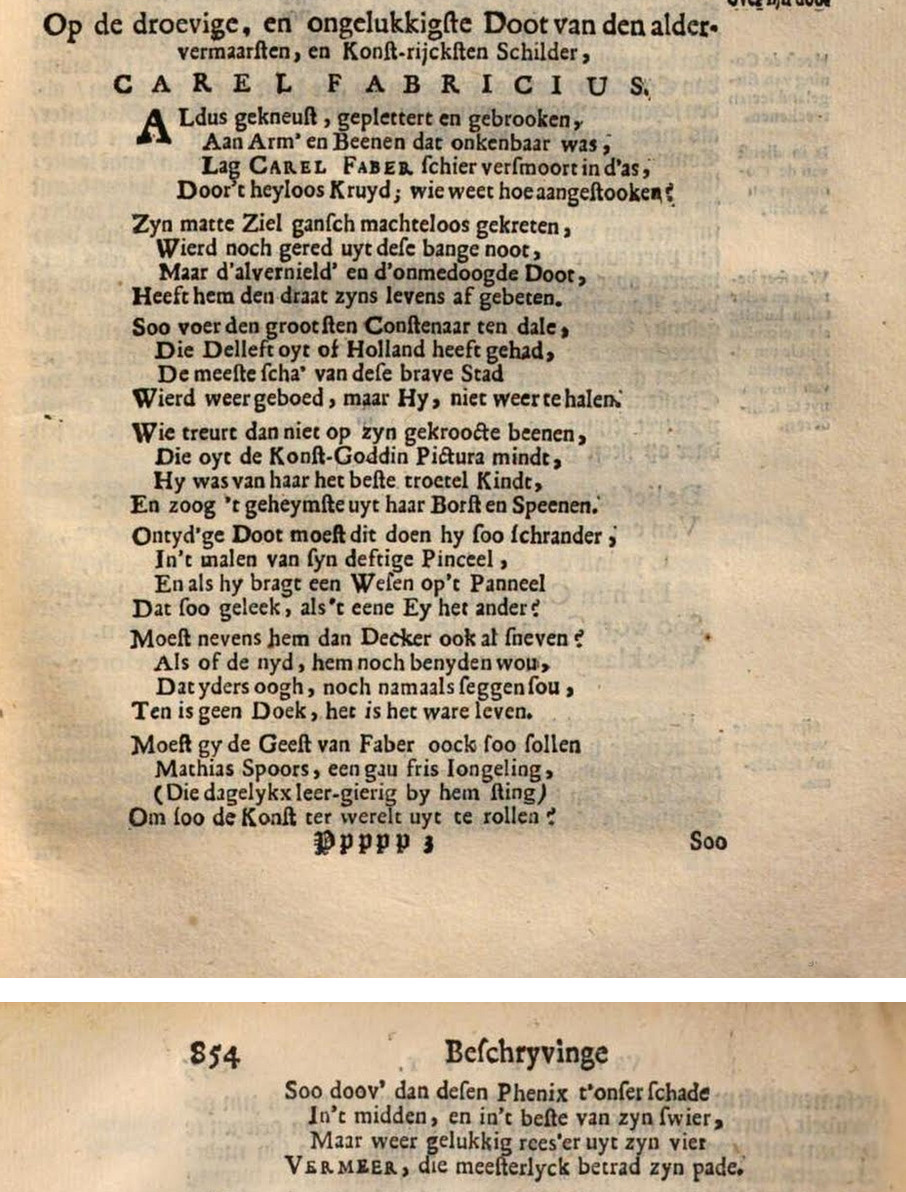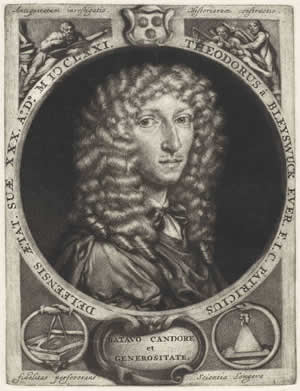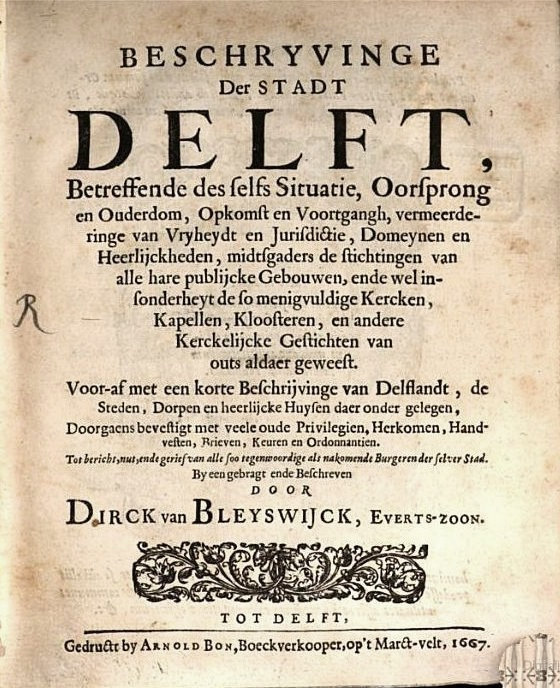Very few surviving documents link Vermeer's name with his profession. One of the most significant is found in Dirck van Bleyswijck's Beschryving der Stadt Delft (Description of the City of Delft) published in 1667.
Vermeer's name is mentioned twice in Bleyswijck's book. The first (page 859) only mentions his name and birth, 1632, in a list of eminent Delft painters who were still alive at the time the book was being written.
The second mention is in a poem of eight stanzas written by Arnold Bon (before 1634–1691), Van Bleyswyck's publisher. The poem, "Op de droevige, en ongelukkigste Dood van den aller vermaardsten, en konstrycksten schilder, CAREL FABRICIUS," was composed in the honor of Carel Fabritius (1622–1654) who had died in the infamous ammunitions explosion of Delft.
Vermeer's name is lauded in the poem's last stanza. Seven stanzas are printed on page 853, the eighth stanza is printed on page 854.

Dirck van Bleyswijck
Published in 1667 (page 859)
Click here to listen to the Dutch pronunciation of Arnold Bon's stanza (courtesy Marco Schuffelen)

Dirck van Bleyswijck
Published in 1667 (page 854, last stanza)
Art historians have long debated the significance of this brief tribute, attributing multiple meanings to it. The most obvious is that after the death of Fabritius, Vermeer was considered the foremost artist of Delft, a fact that challenges the long-held belief that Vermeer was neglected by his contemporaries. However, some earlier critics interpreted this as an indication that Vermeer had studied under Fabritius, a hypothesis that conflicts with the timeline of Fabritius' stay in Delft and Vermeer's youth.
The Dutch art historian Albert Blankert was the first to note that the poem exists in two different versions, even though there is only one edition of the book

Dirck van Bleyswijck
Published in 1667 (page 853 and
854, with eight-stanza poem by Arnold Bon)
While the last line of the first version reads, "Vermeer, die meesterlyck betrad zyn pade" ("Vermeer who masterfully trod in his path") the line had, at some point, been changed to"Vermeer, die 't meesterlyck hem na kost klaren" ("Vermeer, who masterfully emulated him"). The changes seem to make it clear that Vermeer hadn't simply followed Fabritius' footsteps "but was able to paint as well as he and had succeeded him as Delft's leading painter."
Arnold Bon, who wrote the poem, was the printer of the book, and may have thought of the change himself. But according to the art historians Laber Blankert, "it is quite possible that it was suggested by Vermeer, who lived near Bon on the Market Square. Legal records show that Vermeer's obsession with precision was not restricted to his paintings. In two surviving documents he had his name crossed out and corrected, apparently because he found fault with the spelling (see documents of 14 December 1655 and 13 July 1670). This is the more remarkable because his Dutch contemporaries often spelled their names in various ways themselves. Vermeer presumably took written statements about himself and his art very seriously, and if he was not satisfied with the first version of the stanza he might well have persuaded Bon to change the typesetting."Albert Blankert, "Vermeer and his Public, " in Vermeer, edited by Albert Blankert, Gilles Aillaud, and John Michael Montias, (Woodstock and New York: Overlook Duckworth, 2007), 165. The art historian Arthur K. Wheelock Jr. concurs with Blankert, observing that "the artist was hardly modest in his concepts. "At the very least he must have been familiar with stories about artists competing with each other. As far as he must have been concerned, Vermeer versus Fabritius could be added to the list of Apelles versus Protogenes, Raphael versus Michelangelo, Albrecht Dürer versus Lucas van Leyden, and Rembrandt versus Rubens."Ben Broos, "On Celebre Peijntre nommé Verme[e]r," in exh. cat. Johannes Vermeer. Arthur K. Wheelock Jr. and Ben Broos, London and New Haven: Yale University Press, 1995, 52. After all, The Art of Painting, was probably painted in or around 1667, when Beschryvinge der Stadt Delft was published, expressed Vermeer's high ideals about his trade and calling.
Dirck van Bleyswijck

Johannes Verkolje
1671
Mezzotint, 174 x 133 mm.
Rijksmuseum, Amsterdam
Dirck Evertsz. van Bleyswijck was born into a prominent family. He was a sheriff, orphan master, burgomaster, and author of a two-volume Delft history book. He is known to have traveled extensively throughout the Seventeen Provinces. He lived in De dubbelde Sleutels (The Double Keys) on Oude Delft number 93 in Delft. He was also the proud owner of the large painted map of Delft, now in Prinsenhof, which shows the extent of the damage of the 1536 fire. Van Bleyswijck must have been an extremely resourceful Dutchman full of love and pride for his beloved Delft.
At the time the Beschryvinge der Stadt Delft was published, Van Bleyswijck was only twenty-seven years old. The idea for the book was born in a peculiar circumstance. Although Van Bleyswijck was "forced by an illness to abandon plans for a tour of the Netherlands, France and Italy, he decided to take advantage of his condition to explore the history of his hometown. Van Bleyswijck believed that his love of Delft was shared by many of his fellow townspeople. Yet he sensed a change in outlook, complaining in his preface that a whole generation was growing up who were interested only in things from far-off lands and no longer concerned themselves with their own heritage. Clearly, prosperity and the worldwide expansion of the republic had profoundly influenced the thinking of many Delft burghers by the third quarter of the seventeenth century."Walter Liedtke, Michiel C. Plomp, and Axel Rüger, Vermeer and the Delft School (New York: Metropolitan Museum of Art, 2001), 200. The book is the history of the city with descriptions of the greatest accomplishments of its citizens and all of its important monuments. Some years later (1675), the Delft town council commissioned a celebratory map called the Kaart Figuratif. Van Bleyswijck was put in charge.

Delft, 12 October, 1654
Egbert Lievensz. van der Poel
c. 1654–1660
Oil on panel, 37 x 62 cm.
Rijksmuseum, Amsterdam
The stanza dedicated to Vermeer which mentions the tragic loss of Fabritius alludes to the infamous powder explosion of Delft which had destroyed a sizable section of the city on the morning of Monday, 12 October, 1654, at 10.30 a.m. The powder magazine lay in the North-East corner of the town, near to the Geerweg. According to the account given by Dirck van Bleyswijck, at the time of the explosion the magazine contained between 80,000 and 90,000 pounds of powder, and the force of the explosion was so great that it completely destroyed all the houses in the are bounded on the North by the Geerweg, on the West by the Verwersdijk, on the South by the Doelenstraat, and on the East by the Singel canal; many houses beyond were wrecked and there was less damage throughout Delft. Of the magazine itself, nothing was left, and on its site was a deep pool full of water. The number of those killed was never known; among them was Carel Fabritius, who was found dying amidst the ruins. The area of complete devastation was not rebuilt and served afterward as a horse market, and much of it is an open space to this day.'

(Description of the City of Delft)
Published in 1667
Van Bleyswijck had mixed feelings about war and peace in the military town of Delft: "It is chilling to see these houses spit out their innards so that all terrible instruments invented in order to shorten mans life are brought forward." But he sees the need to prepare for war during times of peace and he prays for the blessing of the Almighty.It has been suggested that Van Bleyswijck's description of the former Old Men's House, which once stood opposite the Mechelen where Vermeer was raised and from which he may have looked out to paint his famous Little Street, is consistent with the look of Vermeer's painting
That these houses are very old (and accordingly have proportionately great similarity and resemblance to their occupants) is evident enough from the simplicity of construction,…being without any show, ostentation, or ornament to be seen on the outside, lying quite behind and between the houses, simply with a gate giving on to the common street, yet…with a roomy inner court with small houses and rooms provided round it, so that the aged folk could each have a separate free dwelling and in their great age daily await the day of the Lord.